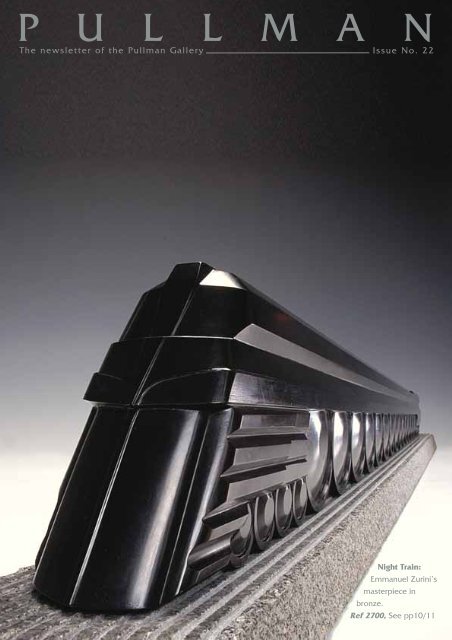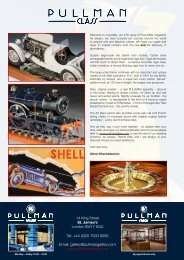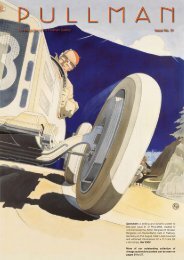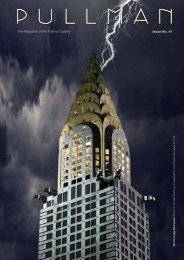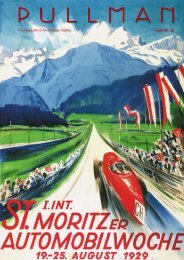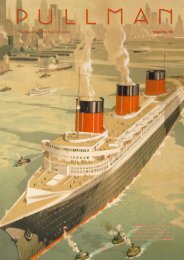Issue No. 22 - Pullman Gallery
Issue No. 22 - Pullman Gallery
Issue No. 22 - Pullman Gallery
- No tags were found...
Create successful ePaper yourself
Turn your PDF publications into a flip-book with our unique Google optimized e-Paper software.
P U L L M A N<br />
The newsletter of the <strong>Pullman</strong> <strong>Gallery</strong><br />
<strong>Issue</strong> <strong>No</strong>. <strong>22</strong><br />
Night Train:<br />
Emmanuel Zurini’s<br />
masterpiece in<br />
bronze.<br />
Ref 2700, See pp10/11
The World according to <strong>Pullman</strong><br />
Luxury Variety<br />
The dictionary defines diversity as ‘the condition of being different.’ In this issue of<br />
PULLMAN we have set out to showcase a superb selection of diverse objets de luxe<br />
from our unique collection.<br />
Authenticity, provenance and condition are everything, and strong demand for these<br />
substantial pieces is both a reflection of the continuing interest in this exclusive<br />
collectors’ market, and proof that you - the sharp-eyed readers of PULLMAN -<br />
recognize and possess immaculate taste.<br />
Our centre pages focus on a powerfully original composition of a 1929 Bugatti Type<br />
43 Grand Sport, Art Deco symbol of speed and modernity, a most covetable and<br />
massive oil on canvas showing the unmistakable influence of the gifted avant-garde<br />
artist Sonia Delaunay. Another engrossing double-page spread features the streamline<br />
look and ´´ elegançe francais of the great Emmanuel Zurini. His stylised Night Train, quite<br />
outstanding, provides our striking front cover picture. <strong>No</strong>r is the eye ever less than<br />
delighted with the sharply nostalgic images of leading masters of automobile art<br />
Frederick Gordon Crosby and Peter Helck, equally represented on these pages.<br />
Riding the skies is renowned painter of the air Lucio Perinotto, recapturing the spirit of<br />
flying’s glamorous past in three major works on canvas. Glittering prizes include a fine<br />
historic motor-boating racing trophy presented by that most versatile of sportsmen, Sir<br />
Thomas Lipton, recalling a vanished age of racing and record-breaking on water. A<br />
collection of Sterling silver trophies, paintings and posters conjure up the recreational<br />
joys of horseplay on the polo field.<br />
Elsewhere, you will find suitably exclusive period objects from the world’s greatest<br />
luxury goods makers - Hermes, ` Louis Vuitton and Tiffany among them - individually<br />
designed and craftsman-made with customary restrained flair. The original, as the<br />
saying goes, is usually the best.<br />
Take your pick: a finely<br />
preserved set of twelve<br />
Sterling silver lobster<br />
picks. The double-ended<br />
design for use on both<br />
body and claws of<br />
the shellfish. Each pick<br />
hallmarked Sheffield,<br />
1935. Complete with<br />
original purple-lined, fitted<br />
case. Crustaceologists<br />
please step forward.<br />
Ref 2652<br />
<strong>No</strong>velty value: (left) the upright<br />
attitude of the genial Penguin<br />
family was the inspiration for this<br />
novel pair of heavy-cast, silverplated<br />
candlesticks. Both<br />
decorative and usable in a<br />
modern context. American,<br />
c.1930’s. Height of each 6’’ (15<br />
cm). Ref 2641<br />
“Rara Avis”: (right) by a common<br />
verdict, Emil Schuelke’s typically<br />
ingenious design in the form of a<br />
lovable penguin is one of the<br />
most acclaimed novelty cocktail<br />
shakers of all time. The beak<br />
opens to reveal a rubber stopper<br />
and pourer. First introduced by<br />
American maker Napier for the<br />
1936 Christmas season, surviving<br />
shakers are keenly sought-after in<br />
today’s market. Height 12’’ (31<br />
cm).Ref 1436<br />
www.pullmangallery.com<br />
Tellingly, the finishing touch to this <strong>22</strong>nd edition of PULLMAN is provided by the truly<br />
diverse: a rare Battle of Britain Operations Room sector clock. A defining moment in<br />
British history, the Battle of Britain gave iconographic status to Spitfire and Hurricane<br />
fighter aircraft and the “Few” who flew them in 1940. Touched by history, this<br />
remarkable restored timepiece is a reminder of the most famous of all air battles. The<br />
stuff of dreams and legend.<br />
Until next time,<br />
Simon Khachadourian.<br />
14 KING STREET<br />
ST JAMES’S<br />
LONDON SW1Y 6QU<br />
TELEPHONE: (+44) 020 7930 9595<br />
116 MOUNT STREET<br />
MAYFAIR<br />
LONDON W1K 2NH<br />
Anchored-down: a<br />
stylish cased set<br />
of twelve nauticallythemed<br />
place-card<br />
holders, imaginatively<br />
shaped to resemble a<br />
ship’s lifebelt. Alloriginal<br />
sets in<br />
complete and near<br />
perfect condition are<br />
now hard to come by.<br />
Of 1950s origin, and<br />
characteristic of the<br />
timeless appeal of<br />
Hermes’ ` luxury items.<br />
Ref 2660<br />
All American; a trio of impressively<br />
substantial black glass cocktail shakers<br />
embellished with Sterling silver overlay<br />
and fluted silver-plated necks, with red<br />
Bakelite stoppers. Made by Rockwell,<br />
c.1930’s. Height of each 16’’ (40 cm).<br />
The rise and rise of consumer interest in<br />
20th century innovation led to a vogue<br />
among contemporary designers to<br />
adopt resin-based Bakelite to<br />
decorative effect.<br />
Ref 2688, 2613, 2614<br />
Email : sk@pullmangallery.com Website:www.pullmangallery.com<br />
PULLMAN <strong>Issue</strong> <strong>No</strong>: <strong>22</strong><br />
3
Seen at Annabel’s<br />
Where else An enthralling line-up of beautifully finished vintage Art Deco cocktail shakers and<br />
bar accessories, featuring pieces by Asprey, Cartier, Hermes ` and Tiffany (a little name dropping<br />
is irresistible) from <strong>Pullman</strong>’s unique collection.<br />
The scarce 1927 ‘Boston Lighthouse’ shakers (in both sizes), the 1919 ‘Tank’ cocktail set, ‘Golf<br />
Bag’ shaker from 1926 and the unusual Henckel’s ‘Aeroplane’ set from 1927 are all of special<br />
interest.<br />
www.pullmangallery.com<br />
www.pullmangallery.com<br />
4 PULLMAN <strong>Issue</strong> <strong>No</strong>: <strong>22</strong><br />
PULLMAN <strong>Issue</strong> <strong>No</strong>: <strong>22</strong><br />
5
<strong>Pullman</strong> Variations<br />
Hunted down<br />
Rear view<br />
www.pullmangallery.com<br />
“Aviary”: a Service size table lighter, one of<br />
the rarest of Alfred Dunhill’s classic 1950s<br />
aquatic-themed lighters. The decorative finish<br />
to the Perspex achieved by consumate<br />
craftsman Ben Shillingford, using the reverse<br />
intaglio technique. <strong>No</strong> two designs were the<br />
same - but this distinctive wildfowl motif was<br />
exceptional. Signed Dunhill on the lift-arm.<br />
Ref 2646<br />
Front view<br />
Victorians uncovered: a uniquely explicit ivory cutter and vesta case. One side engraved “Windsor Gentlemens’ Club” and<br />
the other with a finely carved erotic scene depicting a resourceful young woman expanding her sexual horizons by<br />
pleasuring two of the club’s senior members (sic) at the same time. The lid of the vesta case adorned with an equally erotic<br />
crest. An English rarity, c.1880, exploring beyond the limits of the Victorian moral code, and dating from the days when<br />
“there were only two types of women...” Uncensored photograph available upon request! Ref 2682<br />
Cigaresque: (left)<br />
even the fiercest<br />
anti-smoker could<br />
not deny the quality<br />
of this fine leather<br />
cigar drum. The<br />
silver mounting and<br />
silver cartouche<br />
add distinction.<br />
French c1930’s,<br />
height 7’’ (18 cm).<br />
Ref 2462<br />
Tiffany: sumptuous<br />
and unusual<br />
Sterling silver cigar<br />
humidor of large<br />
proportions. The<br />
cedar lined body,<br />
can accommodate<br />
up to 50 cigars. Fitted humidifier to the removable lid.<br />
Signed Tiffany, c.1930. Height 8’’ (20 cm). Ref <strong>22</strong>37<br />
CENSORED!<br />
Variation on a theme: a rare commodity<br />
in the form of a combined pistol and knife<br />
by English makers Unwin & Rogers,<br />
c.1880. Remarkably, a brass implement is<br />
supplied to produce tailor-made bullets,<br />
and a separate compartment is reserved<br />
for the cartridges. In a category of one.<br />
Length: 7" (18cm). Ref 2681<br />
Cool conscious: cold storage - the first<br />
requisite of serving Champagne - in the form<br />
of an unusual vintage, silver-plated<br />
Champagne bucket inspired by hunting. The<br />
martele body with applied rosette featuring a<br />
well-cast stag's head motif. Matching handles<br />
designed to resemble the noble heads of<br />
hunting dogs. Made in Austria, c.1930.<br />
Height: 10" (25cm). Ref 2678<br />
Detail<br />
Bowled over: distinctive and original<br />
punchbowl inspired by an Edwardiian<br />
hunting theme. The ornate<br />
decoration showing stags, wild<br />
boar and hunting dogs in high<br />
relief. The<br />
cover with<br />
figural finial of a Scottish<br />
huntsman in traditional<br />
dress, and bearing a<br />
shotgun. Complete with<br />
ladle. German makers’ mark<br />
WMF, Wurtemmbergische<br />
Machinen Fabriken, with there<br />
registration mark prominent.<br />
Outstanding. Height: 21"<br />
(53cm) Ref 2679<br />
Knife edge: an unusual giant penknife, a rare novelty in<br />
excellent unmarked condition, comprising two steel blades,<br />
nickelled ends and a fitted plaque. American-made, of 1930s<br />
origin, and manufactured for use as a cutler's display item.<br />
Length (closed)11" (28cm). Ref 2651<br />
www.pullmangallery.com<br />
6 PULLMAN <strong>Issue</strong> <strong>No</strong>: <strong>22</strong><br />
PULLMAN <strong>Issue</strong> <strong>No</strong>: <strong>22</strong><br />
7
Presenting its own case<br />
The case of Louis Vuitton<br />
www.pullmangallery.com<br />
Checkered history: travel for its own sake<br />
was once the preserve of the affluent, and<br />
Louis Vuitton, founded in Asnieres ` during the<br />
reign of Napoleon III, is a name forever<br />
associated with the art of luxury<br />
travel. The characteristic<br />
leather and coarse-grained<br />
monogrammed canvas<br />
(introduced in 1896) soon<br />
became an expression<br />
of contemporary taste.<br />
In the age of the<br />
excess-baggage mode<br />
of travel, Louis Vuitton<br />
luggage pieces were<br />
de rigeur among the<br />
sophisticated It is a<br />
truism that Louis Vuitton -<br />
who still rigorously select<br />
the correct wood for their<br />
creations - never miss the<br />
mark when it comes to<br />
matching their designs with<br />
the fashion of the<br />
times.<br />
On all counts,<br />
our gallery in<br />
Mount Street,<br />
Mayfair holds<br />
one of the<br />
most highly<br />
selective collections of<br />
vintage cabin trunks,<br />
humidors and accessories<br />
by the premier French<br />
maker.<br />
www.pullmangallery.com<br />
Beyond elegant: a real<br />
sense of tradition and<br />
attachment to quality<br />
exampled by this<br />
most valuable 1930s<br />
crocodile gentleman’s<br />
dressing case by<br />
Hermes. ` The interior,<br />
fitted to perfection,<br />
includes a selection of<br />
hallmarked and signed<br />
Sterling silver brushes,<br />
cologne bottles, jewellery boxes and a manicure set. A neat touch is<br />
provided by the secret compartments and a document case to the inside of<br />
the lid sets off the case to great advantage. All fitments and locking devices<br />
signed Hermes, ` Paris. Truly worthy of Hermes’ ` proud heritage and of real<br />
interest to serious collectors worldwide. Ref 2606<br />
Detail<br />
Louis Vuitton: a magnificent and fully fitted necessaire de voyage c.1926, the dark<br />
green leather case containing a variety of Baccarat crystal bottles, flasks and jars<br />
all with Sterling silver and rare blonde tortoise-shell covers, the removable tray<br />
fitted with brushes, jars, a hand mirror, extensive manicure set and a large<br />
photograph frame all in blonde tortoise-shell and Sterling silver, each individual<br />
piece with exquisite 18 carat rose gold inlaid Art Deco motif, various leather<br />
jewellery boxes in hidden compartments, the case lined with dark green moire´<br />
silk. Included is the original fitted canvas outer cover monogrammed ‘V.S’, which<br />
has protected the case for 80 years, accounting for its remarkable condition. Serial<br />
number 741359, lock number 047827, extensively marked and hallmarked Louis<br />
Vuitton, Paris. French c. 1926. Width overall 24’’ (62 cm). Ref 2650<br />
8 PULLMAN <strong>Issue</strong> <strong>No</strong>: <strong>22</strong><br />
PULLMAN <strong>Issue</strong> <strong>No</strong>: <strong>22</strong><br />
9
The Magnificent Zurini<br />
www.pullmangallery.com<br />
www.pullmangallery.com<br />
Track star: the impressive profile of Emmanuel Zurini's undisputed masterpiece Night Train. The stealth black-patinated<br />
bronze, futuristically contoured, is set on a grey granite plinth and measures a formidable 63’’ (160cm) in length. One of<br />
only five surviving examples (the maquette was destroyed - before the remaining three examples could be cast) and<br />
absolutely in a class of its own. Ref 2700<br />
Emmanuel Zurini, born in France in 1942, and better known as “Manou”, trained as an artist and photographer. He<br />
transformed the look of Formula One in the 1960s and his compelling photographs formed the backdrop for countless<br />
Grand Prix and Le Mans 24 Hour race posters of the period. In 1975, his energies expanded to include sculpture, working<br />
in bronze or stone. His surpremely stylistic automotive sculptures created over the past three decades are his most<br />
important legacy.<br />
An innovative approach to styling has led to major commissions from the world of Formula One and for the Pebble Beach<br />
Concours d’elegance. The prestigious Car of the Year Trophy was designed by Zurini in 2004. He favours very limited<br />
edition casts - usually of eight pieces - and Michael Schumacher, Jacques Villeneuve and Flavio Briatore, among others,<br />
are devotees of his seductively sculpted bronzes.<br />
Name dropping: a rare collection of Zurini’s most significant automotive sculptures - nominally inspired by the principal<br />
of minimum drag and drawing on the rich heritage of international competition. All signed by the artist, all mounted on<br />
original plinths, and all presented with a fitted carrying case hand-crafted by Zurini. Size 21’’- 30’’ (54 x 76cm).<br />
Ref 2673 Ref 2671<br />
GT40: (far left) Zurini's celebrates the classic 1964 Ford GT40 track<br />
car in futuristic form. Black patina finish to the bronze. Numbered<br />
1/8, dated 2002. Ref 2673<br />
XJ13: (left) stylised version in bronze of Jaguar's efforts to construct<br />
a high performance, mid-engined competition car in 1968.<br />
Numbered 3/8, dated 1989. Ref 2671<br />
REIMS: (above) homage in bronze to the fabled 1955 Grand Prix<br />
Mercedes Benz W196, widely known as the "Streamliner".<br />
Numbered 2/8, dated 2004, Ref 2672<br />
DUNCAN: (above right) bronze rendering of the one and only "D"<br />
Type Jaguar campaigned by Britsh privateer Duncan Hamilton.<br />
Finished in black. Numbered 1/8, dated 2004, Ref 2698<br />
CARACCIOLA: (right) a striking silvered bronze commemorating<br />
Rudi Caracciola's all-conquering 1937 Grand Prix Mercedes W154.<br />
Numbered 1/8, dated 2001, Ref 2699<br />
Ref 2672 Ref 2698<br />
Ref 2699<br />
10 PULLMAN <strong>Issue</strong> <strong>No</strong>: <strong>22</strong><br />
PULLMAN <strong>Issue</strong> <strong>No</strong>: <strong>22</strong><br />
11
Bugatti Moderne<br />
www.pullmangallery.com<br />
www.pullmangallery.com<br />
Feminine inspiration: historically significant and<br />
highly expressive oil on canvas of massive<br />
proportions, painted in 1929 and showing the<br />
unmistakable influence of gifted avant-garde artist<br />
Sonia Delaunay. “Jazz, hectic pace movies, America,<br />
airplanes, the automobile,” wrote Bauhaus director<br />
Oskar Sclemmer in 1925, “these are the terms in which<br />
people think.” The creator of the most glamorous fast<br />
cars racing in the 1920s was Ettore Bugatti, whose pur<br />
sang automobiles were fine examples of the standard<br />
of workmanship which Le Patron (as Bugatti was<br />
Bugatti: Preliminary sketches for fabric design by<br />
Sonia Delaunay, c. 1925.<br />
known) demanded in his quest for perfection.<br />
The various strands that form this magnificent rendering of Bugatti’s 1929 Type 43 Grand Sport<br />
suggest a crossover between Cubism and Futurism. The vintage thoroughbred cresting the<br />
brow of a hill, dust clouds dominant, is an intense, defining image of luxury, modernity and<br />
speed.<br />
It is not without interest that during the Great War The Observer in a startlingly prescient<br />
judgement, informed readers that “the reviled Post-Impressionists, Cubists, Futurists,<br />
Expressionists, Vorticists of today may be the honoured masters of tomorrow.” Well said.<br />
Dimensions: 98’’ x 46’’ (249 cm x 108 cm). Ref 2676<br />
Artist at work: the Ukranian-born Sonia Terk<br />
(afterwards Delaunay, 1885-1979) was an artist in<br />
every sense of the word. She produced, in a long<br />
and prolific career, easel paintings, murals,<br />
ceramics, mosaics, stained glass and theatrical,<br />
graphic, fashion and interior designs. She<br />
memorably prepared, in painterly fashion, a Bugatti<br />
Type 35 for display at the 1925 Paris Exposition.<br />
She is pictured on the bonnet of the Grand Prix car<br />
wearing one of her own creations - a matching<br />
Simultaneous dress. Sonia Delaunay, together with<br />
her French husband, the painter Robert Delaunay,<br />
was a leader of a developing style called Orphism<br />
(sometimes referred to as Organic Cubism). An<br />
early advocate of colour theory, her sharply<br />
Sonia Delaunay and companion with the Citröen she<br />
decorated for the Art Deco exhibition, Paris 1925.<br />
Modernist designs (much coveted by among others silent movie star Gloria Swanson, and<br />
socialite Nancy Cunard) launched a vogue for contrasting colour and became all the rage. It is<br />
a measure of her enduring passion for fast cars that as late as 1967 she was creating a highly<br />
individualistic design for the Matra 530.<br />
12<br />
PULLMAN <strong>Issue</strong> <strong>No</strong>: <strong>22</strong> PULLMAN <strong>Issue</strong> <strong>No</strong>: <strong>22</strong><br />
13
Painter of the Air<br />
Flypast: aviation has always been a dynamic and dramatically<br />
developing industry, as evidenced by these outstanding oils<br />
on canvas by Lucio Perinotto. Born in Bordeaux in 1949, of<br />
Italian origin, Perinotto is acknowledged as one of the<br />
foremost aviation artists of his generation. His high<br />
contemporary reputation rests on a sequence of<br />
monochrome works recapturing the very essence of flying’s<br />
glamorous past. A distinguished contributor to air-minded<br />
journals in Europe, his work is widely collected (and widely<br />
admired by the Powers That Be in the French aviation<br />
industry). Examples of his large format paintings are<br />
exhibited in leading corporate and public collections,<br />
including EADS (manufacturers of Airbus), the Paris Museum<br />
of the Air, the Air France Museum at Le Bourget, the Orly<br />
<strong>Gallery</strong> and the Paris Seaplane Museum.<br />
The first commercial air crossing of the Atlantic was made by<br />
a Pan Am flying boat but the slower seaplanes were gradually<br />
eclipsed, once weight made ground landings possible. That<br />
said, the golden era of the giant flying boats exudes an aura<br />
of romance and retains a fascination for many, Lucio Perinotto<br />
not least among them.<br />
www.pullmangallery.com<br />
Right: ‘DC4 over New York City’. Oil on canvas 24’’ x 48’’<br />
(60 x 120 cm). Ref 2668<br />
Below right: ‘Constellation’. Oil on canvas 36’’ x 58’’<br />
(90 x 146 cm). Ref 2667<br />
Below: ‘Sunderland flying boat’ Oil on canvas 39’’ x 52’’<br />
(97 x 130 cm) Ref 2666<br />
www.pullmangallery.com<br />
14 PULLMAN <strong>Issue</strong> <strong>No</strong>: <strong>22</strong><br />
PULLMAN <strong>Issue</strong> <strong>No</strong>: <strong>22</strong><br />
15
Masters of the Art<br />
www.pullmangallery.com<br />
French bleu: the vintage era evoked in this finely<br />
conserved poster for the smartest of French marques.<br />
Louis Delage founded his own company in 1905, and was<br />
a dominant force in Grand Prix and sports car racing. La<br />
belle voiture Francaise soon gained a reputation for stylish<br />
appearance and quality, and the celebrated “D” series<br />
(pictured) reigned supreme in the heyday of Concours<br />
d’Elegance. Unsurprisingly, the 1930s Depression<br />
accounted for the downturn in the financial fortunes of<br />
luxury makers and the Delage name was auctioned off to<br />
Delahaye mid-decade. Printed by Editions Mathis, Paris,<br />
c.1930. Linen-mounted. Dimensions: 63’’ (160 cm) x<br />
48’’ (120 cm). Ref 2750<br />
Supercharged: an<br />
interesting pairing of two<br />
immortals of automobile<br />
art (right) Frederick<br />
Gordon Crosby’s style<br />
attracted both followers<br />
and imitators but his work<br />
was rarely equalled<br />
between the wars. His<br />
wonderfully evocative<br />
watercolour depicts the<br />
1930 Irish Grand Prix, and<br />
the “heavy metal” of<br />
privateer Sir Henry “Tim”<br />
Birkin’s Blower Bentley<br />
(no.8) at breakneck speed,<br />
with German champion<br />
Rudi Caracciola’s vast<br />
supercharged Mercedes in<br />
pursuit, and Brooklands<br />
Riley (no.45) snaking to<br />
the right at the sinuous<br />
Phoenix Park circuit, 1930.<br />
Signed and dated,<br />
dimensions 28’’ x 18’’ (71<br />
x 46 cm). Ref 2086<br />
Return to sender: (right) intriguing rediscovery of<br />
correspondence between the founding father of American<br />
automotive art Peter Helck (1893–1988) and the great<br />
Edwardian racing driver Louis Wagner. A watercolour<br />
heightened with gouache, rendered on the front of an<br />
envelope, depicting Wagner’s Fiat at speed in the 1910<br />
Savannah Races. Their enduring friendship was chiefly<br />
conducted by airmail, inspiring Helck occasionally to<br />
illustrate envelopes with scenes of Wagner’s major<br />
successes. This unique example was returned in perfect<br />
condition to the artist following the driver’s death in 1970.<br />
Dated December 18th 1950, Boston, and acquired from a<br />
member of Helck’s close circle, who received the<br />
watercolour as a gift. Ref 1210<br />
www.pullmangallery.com<br />
Star turn: a particularly fine gilded<br />
bronze, featuring a race-bred Mercedes<br />
Benz at speed by the accomplished<br />
German artist Richard Lange. Both the<br />
intrepid driver, and riding mechanic<br />
(once compulsory in competition), a<br />
model of concentration. Set on a<br />
bronze sôcle , evoking clouds of dust<br />
characteristic of the heroic era of road<br />
racing, when Mercedes achieved great<br />
success in building and racing cars.<br />
Mounted on original marble plinth.<br />
Signed R. Lange, c.1928. Length: 13"<br />
(33cm). Ref 2680<br />
16 PULLMAN <strong>Issue</strong> <strong>No</strong>: <strong>22</strong><br />
PULLMAN <strong>Issue</strong> <strong>No</strong>: <strong>22</strong><br />
17
Sporting Life<br />
Detail<br />
Hermes ` Paris: a very rare set of 12 Sterling<br />
silver place card holders depicting two polo<br />
players in relief, signed ` Hermes Paris, French<br />
c. 1950’s. Ref 2703<br />
www.pullmangallery.com<br />
Jean Jacquot: (above) Deauville Saison de Polo<br />
1938, a rare and stylish original poster depicting the<br />
two teams in play. Linen mounted, framed and<br />
glazed, French c.1938. Dimensions 34'' x 49'' (87 x<br />
125 cm). Ref 2701<br />
“At speed”: (top right) there is no denying the<br />
quality of this dramatic large format charcoal<br />
drawing of a polo player in action by George<br />
Denholm Armour (1864-1949). The Scottish Royal<br />
Academician’s early life was spent in Tangiers, where<br />
he bred - and painted - horses. Afterwards a stud<br />
farmer in England, he commanded a cavalry division<br />
during the First World War. Armour was appointed<br />
OBE in 1919. His equine inclinations led to regular<br />
cartoon commissions from The Tatler, Punch and<br />
Country Life and his equestrian portraits of society<br />
figures were equally impressive. Ref 2693<br />
Chukking it in: (right) a rare original oil painting on<br />
board of a polo match in progress by celebrated<br />
Austrian artist Carl Franz Bauer (1879-1954). Bauer is<br />
arguably one of the most meticulous and underrated<br />
of illustrators - his accomplished work surely<br />
deserving of belated recognition. Dimensions 18” x<br />
14” (46cm x 35 cm). 1930. Ref 2675<br />
Box clever: an imposing Austrian cigar box,<br />
c.1910, after a design by eminent American<br />
sculptor Herbert Haseltine, famous for his<br />
monumental polo and other equestrian<br />
bronzes to be found in the Whitney Museum,<br />
New York. The box with stylish polo player<br />
depicted in relief to the hinged lid, the sides<br />
bound and riveted as a strong-box, interior<br />
lined with hardwood. Austrian, c.1910.<br />
Length: 9” (23cm) Ref.2643<br />
Victorious: a group of early silver and silver<br />
plated polo trophies, comprising clockwise<br />
from left: a good black onyx glass cigar box<br />
with Sterling silver overlay Ref 2694, a rare,<br />
early silvered-bronze car mascot of a polo<br />
player by Lejeune Ref 2654, a large trophy<br />
cup and cover with polo players, Ref 2662, a<br />
fine Sterling silver trophy cup with crossed<br />
mallets by Elkington, hallmarked 1904, Ref<br />
2659 and a similar smaller Sterling silver<br />
trophy cup hallmarked Mappin and Webb<br />
1921, Ref 2687<br />
www.pullmangallery.com<br />
18 PULLMAN <strong>Issue</strong> <strong>No</strong>: <strong>22</strong><br />
PULLMAN <strong>Issue</strong> <strong>No</strong>: <strong>22</strong><br />
19
20<br />
www.pullmangallery.com<br />
Highly Prized Global Reach<br />
“Why<br />
<strong>No</strong>t”: the Sir Thomas<br />
Lipton Cup, a classical Sterling<br />
silver trophy of lasting historical<br />
interest. Winged speed finial prominent,<br />
inscribed to one side beneath his emblem of an<br />
enamelled shamrock: ‘Presented by Sir Thomas<br />
Lipton, BART, KCVO, to the National Yacht Club of<br />
Toronto For Competition Outboard Hydroplane Races<br />
Canadian National Exhibition Regatta 1929’. The<br />
reverse, beneath decorative crossed-enamelled flags,<br />
complemented by a finely embossed racing hydroplane<br />
cresting the waves, in high relief. A Sterling silver plaque<br />
to the ebony campana plinth engraved: ‘Won by<br />
Hilton Frazer In a fifteen mile race September 8, 1930,<br />
driving Why <strong>No</strong>t 4th Time <strong>22</strong>:39’. Hallmarked<br />
Goldsmiths and Silversmiths Company, London<br />
1929. Overall height: 32” (80cm). Sir Thomas,<br />
grocer, consummate sportsman and spirited<br />
challenger for the America’s Cup, was<br />
knighted for his philanthropy by<br />
Queen Victoria. Ref 2649<br />
PULLMAN <strong>Issue</strong> <strong>No</strong>: <strong>22</strong><br />
The celebrated works of Cassandre (Adolphe Mouron, 1901-1968) need no introduction to PULLMAN readers. His widely admired poster designs reveal a stylistic debt to<br />
both Purist principles and the poetic spirit of his friend Le Corbusier. His attraction to pure geometric form is seen in this image created in 1936 to advertise the Trieste-based<br />
shipping company’s global reach. A trio of Ocean liners atop a globe is pictured steaming in-line around the globe.<br />
Passenger services of the Cosulich Line, founded in 1903 by Fratelli Cosulich, operated from Mediterranean ports to New York and South America. A new company, Italia<br />
Cosulich Lloyd Triestino Adria, was formed in 1932. Printed by Editions de Propagande, excellently conserved and linen-mounted. 24” x 37” (62cm x 96 cm). Ref 2669<br />
PULLMAN <strong>Issue</strong> <strong>No</strong>: <strong>22</strong><br />
21<br />
www.pullmangallery.com
Art and Power<br />
Grand Design<br />
www.pullmangallery.com<br />
Detail<br />
“Eva”: the stark beauty of the<br />
refined work of Paul Bronisch<br />
(1904-1989), a leading<br />
representative of the neoclassical<br />
tradition and a<br />
“preferential artist” of the Third<br />
Reich, along with Arno Breker,<br />
Joseph Thorak and Fritz Klimsch.<br />
Bronisch’s work, often<br />
monumental, varied from heroic<br />
themes to nudes. Sculpture,<br />
expressing the National Socialist<br />
obsession with the ideal body,<br />
was used increasingly with<br />
architecture to embody the<br />
“German spirit” of divine<br />
destiny. Favoured by Albert<br />
Speer, Hitler’s chosen architect,<br />
Bronisch’s State commissions<br />
included massive bronzes for the<br />
Reichsbank and Aviation<br />
Ministry. This darkly patinated<br />
bronze figure of “Eva” was<br />
exhibited at the newly-opened<br />
Haus der Kunst in Munich 1938,<br />
Works by banned artists -<br />
notably Picasso - were auctioned<br />
off in Switzerland to raise money<br />
for Nazi party coffers.<br />
Height: 49’’ (125 cm). Ref 2492<br />
Rear view detail<br />
Strings attached: definitive Art Deco boudoir baby grand piano<br />
of the finest quality. The demi-lune case and support exotically<br />
veneered in dark macassar ebony with ivory stringing. The entire<br />
piece in perfect working order, fully restored by Bluthner’s with<br />
special attention to re-stringing and tuning. The matching duet<br />
stool en suite is very rare indeed. By long-established London<br />
makers J.Strohmenger - a name rich in tradition, much respected<br />
in piano - making and well known to musicians and music lovers<br />
for over 150 years. Frame number 20460. c.1938. Width: 54”<br />
(137cm). Art Deco remains the most glamorous and soughtafter<br />
style of the twentieth century. Ref 2697<br />
www.pullmangallery.com<br />
<strong>22</strong><br />
PULLMAN <strong>Issue</strong> <strong>No</strong>: <strong>22</strong><br />
PULLMAN <strong>Issue</strong> <strong>No</strong>: <strong>22</strong><br />
23
Finest Hour<br />
Over Time: a superbly restored and extremely rare R.A.F. Operations Room sector clock with<br />
ribbed hands, red, yellow and blue five/two-and-a-half minute markings and Service crest, the<br />
mahogany case with convex surround and brass bezel, marked AM (Air Ministry) and fusee ´<br />
movement by F.W.Ellott Ltd. Stamped and dated 1939.<br />
In 1940, with the Battle of Britain about to begin, the Royal Air Force possessed the world’s best<br />
aerial defence system, a system of Command and Control based on the plotting of enemy<br />
formations by members of the Women’s Auxiliary Air Force receiving instructions over headsets.<br />
By means of croupier-style rakes, WAAFs positioned numbered marker blocks in red, yellow and<br />
blue to represent the approach of hostile aircraft. “The great room was almost silent”, observed<br />
the American air attache, ´ “only a little movement as operators moved counters and markers from<br />
point to point...”<br />
It is hard to overestimate the advantage of radar in directing intercepting fighters onto attacking<br />
aircraft but successful engagement by Hurricane and Spitfire squadrons depended on fast and timely information. The colours<br />
of the markers changed every five/two-and-a-half minutes according to a colour-coded sector clock mounted prominently<br />
above the plotting table in the Ops room, allowing Controllers to replace a “stale” plot with a “fresh” one. The accuracy of a<br />
sector clock during the heat of a raid was, put simply, a matter of life and death.<br />
This particular example, made to the highest standards by F.W.Elliott, was delivered to R.A.F. Fighter Command before the<br />
Battle. Later, austerity versions (manufactured by Smiths, the instrument makers) were never the equal of their earlier<br />
counterparts. A rare survivor and reminder of the efficiency of this nation’s defensive effort, when the ‘Few’ did indeed save<br />
the many from the unthinkable. Ref 2695<br />
24<br />
PULLMAN <strong>Issue</strong> <strong>No</strong>: <strong>22</strong>


